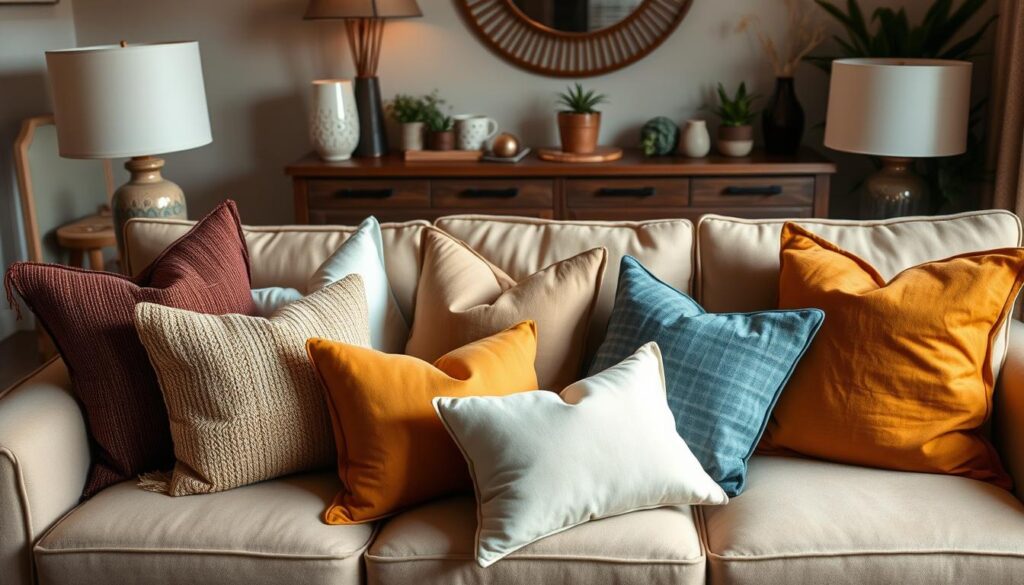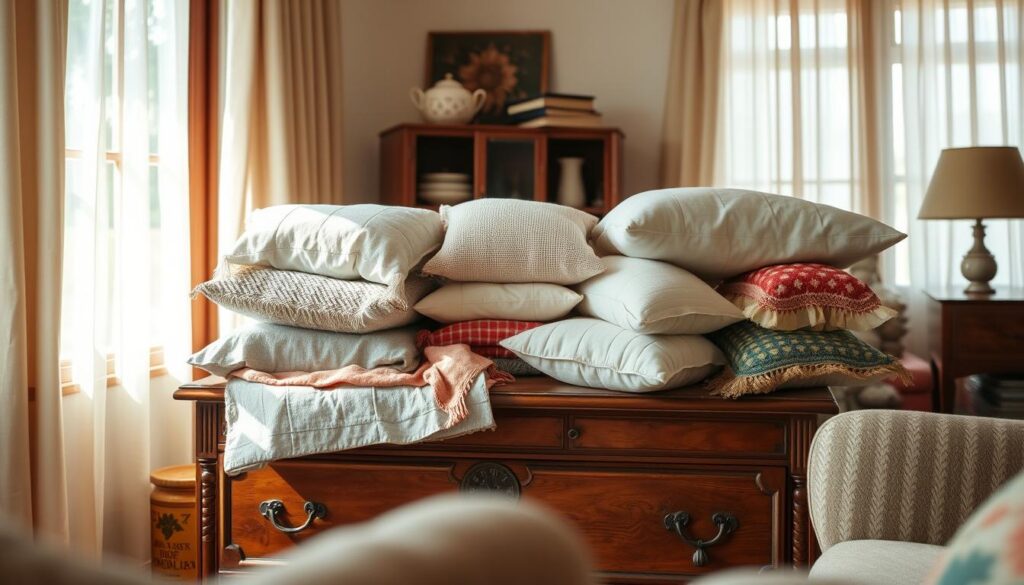Want to refresh your sofa or bed with vibrant new accents? Creating custom decorative pieces doesn’t require stitching skills or expensive tools. With innovative no-sew techniques, you can craft unique designs that match any color palette or texture preference.
This guide focuses on simple, hands-on methods using fabric adhesives, iron-on tapes, and clever folding tricks. Whether you’re drawn to boho patterns, minimalist prints, or luxurious materials like velvet and linen, these approaches let you experiment without hassle.
Why choose DIY? It’s budget-friendly, quick, and perfect for seasonal updates. Imagine swapping throw designs for holidays or mixing colors to elevate your home décor. Plus, you’ll avoid waiting for online orders or paying premium prices.
Key Takeaways
- No-sew methods save time and work for all skill levels.
- Fabric adhesives and iron-on tapes create durable finishes.
- Choose materials like satin or linen for varied textures.
- Customize designs to match seasonal or boho themes.
- Easily update décor without buying new cushions.
Igniting Your Creativity with Stylish Pillow Covers
Your living space becomes a canvas when you embrace no-sew design. The secret? Let bold colors and eye-catching patterns guide your vision. This approach turns basic cushions into conversation starters that reflect your personality.
Discover Unique Color Palettes and Patterns
Start with unexpected combinations. Pair mustard yellow with deep teal or layer geometric shapes over soft floral pillow motifs. Contrast matters: try crisp white against charcoal gray for modern appeal.
Pro tip: Use a 60-30-10 rule. Choose a dominant hue (60%), secondary shade (30%), and accent color (10%). This creates harmony in boho or minimalist spaces alike.
Drawing Inspiration from Trendy Accents
Texture mixing elevates simple designs. Combine glossy satin with nubby linen for tactile interest. Add metallic trims or embroidered patches to plain throw pillow covers.
Small details make big impacts:
- Fringe edges for boho flair
- Iron-on sequins for glamour
- Fabric paint for custom prints
These touches transform basic cushions into coordinated decorative pillow covers that tie your sofa or bed styling together.
Selecting the Perfect Materials and Tools
What’s the secret to long-lasting décor? It starts with smart material choices. Whether updating your sofa or refreshing a bed, the right fabrics and adhesives ensure your creations stay vibrant through daily use.
Choosing the Right Fabric for Comfort and Durability
Families and pet owners should prioritize sturdy textiles. Cotton blends handle frequent washing, while linen resists pilling. Velvet adds luxury but requires gentle care. For high-traffic areas like living rooms, tightly woven fabrics work best.
Consider these factors:
- Texture impacts coziness – smooth satin suits modern styles, chunky knits add warmth
- Match fabric weight to cushion size – heavy materials need thicker inserts
- Opt for stain-resistant finishes in homes with kids
Exploring Alternatives to Sewing Machine Tools
No-stitch methods save time without sacrificing quality. Fabric glue bonds edges securely, while iron-on tape creates crisp seams. For removable throw pillow covers, try hook-and-loop strips.
| Fabric Type | Durability | Comfort | Best For |
|---|---|---|---|
| Cotton | High | Breathable | Everyday use |
| Linen | Medium | Textured | Seasonal accents |
| Velvet | Low | Plush | Decorative pieces |
Measure twice before cutting! Allow extra fabric for adhesive overlaps. Pair bold colors with neutral bases to balance your home décor effortlessly.
Simple DIY Techniques for No-Sew Projects
Discover hassle-free ways to craft custom accents in minutes. Modern adhesives and heat-activated solutions let anyone create polished designs – no stitching required. These methods work equally well for refreshing old cushions or building a coordinated throw collection from scratch.
Using Fabric Adhesives and Iron-On Options
Fabric glue forms invisible bonds that hold through washes. Apply it in thin lines along edges, press pieces together, and let dry. For crisp seams, iron-on tape melts when heated, fusing layers securely. Both options outperform hand-stitching in time savings and consistency.
Try these pro tips for success:
- Test adhesives on scrap fabric first
- Use parchment paper to protect surfaces during ironing
- Cut fabric ½” larger than your cushion for overlap
Personalize plain throw pillow covers with iron-on transfers. Print custom patterns or quotes on specialty paper, then heat-press them onto fabric. This technique lets you match any style – from bold geometrics to subtle colors.
Safety matters! Work in ventilated areas when using adhesives. Store materials away from heat sources. With these methods, even first-timers can produce throw pillow covers that look store-bought at a fraction of the price.
Step-by-Step Guide to Creating Your Pillow Cover
Ready to transform fabric into home décor magic? Follow this foolproof method to craft polished throw pillow covers that fit like a glove. Preparation is key – rushing leads to uneven edges or mismatched patterns.
Preparation and Customization
- Measure your cushion insert precisely. Add 1.5 inches to each side for adhesive overlap.
- Cut fabric using sharp scissors. For removable cases, leave one side open for insert access.
- Apply fabric glue or iron-on tape along edges. Press firmly for 30 seconds to seal.
- Add personality with stenciled colors, fabric markers, or iron-on patches before sealing edges.
- Let dry completely before inserting your throw pillow – patience prevents peeling!
“Measure thrice, cut once. A well-planned project saves time and materials.”
Smart tip: Order fabric swatches online to test textures against your bed linens or sofa upholstery. Many retailers offer sample programs at minimal price points.
| Fabric Type | Best Use | Customization Options |
|---|---|---|
| Cotton | Everyday throw pillow covers | Fabric paint, embroidery |
| Linen | Seasonal accents | Bleach patterns, dye techniques |
| Velvet | Luxury decorative pieces | Metallic trims, beadwork |
Mismatched corners? No stress! Use decorative buttons or ribbon to hide imperfections. Your home should reflect your creativity – not perfectionism. Now fluff those new cases and enjoy your handiwork!
Exploring Unique Textures and Patterns
Texture transforms ordinary accents into showstoppers. By pairing unexpected materials and colors, you create focal points that elevate any room. This approach works equally well for modern sofa arrangements or relaxed boho lounges.
Mixing Bold Prints with Solid Hues
Balance is key when combining patterns. Try anchoring a striped throw pillow with solid navy counterparts. Geometric shapes pop against neutral backdrops, while floral motifs soften angular furniture.
Follow these guidelines:
- Use one large-scale pattern per grouping
- Pair organic shapes (like leaves) with structured lines
- Repeat accent colors across different prints
A recent client transformed their living room using this formula: chevron-patterned decorative pillow paired with charcoal solids. The result? A cohesive yet dynamic style that tied the space together.
Incorporating Accent Pillow Cover Designs
Layering textures adds depth to your throw pillows. Combine nubby linen with smooth velvet for tactile contrast. Metallic threads or embroidered details create visual interest without overwhelming the space.
| Texture Type | Visual Impact | Best Pairings |
|---|---|---|
| Chenille | Soft glow | Leather furniture |
| Bouclé | Modern twist | Mid-century decor |
| Silk | Luxurious sheen | Velvet accents |
Test combinations on small fabric swatches first. Drape samples over your existing cushion to see how light affects colors throughout the day. Remember: Your throw collection should evolve with your tastes – don’t fear mixing vintage finds with contemporary pieces!
Transforming Your Home Decor with Custom Pillow Covers
Imagine walking into a room that instantly feels fresh and inviting. Strategic use of accent pieces creates this magic, and custom pillow covers lead the charge. These versatile elements bridge your existing furniture with new design directions, offering endless styling possibilities.

Harmonizing Accents with Furniture and Bedding
Start by analyzing your dominant furniture colors. A navy sofa pops with terracotta accents, while a neutral bed gains energy from sage green patterns. Follow these simple strategies:
- Pull secondary colors from area rugs or artwork
- Use geometric patterns to modernize traditional spaces
- Add boho flair with tassels or fringe details
Seasonal updates become effortless when you stockpile neutral bases. White linen throw pillow covers transition from summer florals to autumn plaids seamlessly. Layer a chunky knit over smooth velvet for winter texture contrast.
“Three accent pieces can redefine a space’s mood. Start small and build your color story gradually.”
Not sure where to begin? Try this designer trick: drape fabric swatches over your cushion inserts. Observe how morning vs. evening light affects colors. This helps choose designs that shine at your prime lounging hours.
| Furniture Style | Pillow Strategy | Impact Level |
|---|---|---|
| Modern Leather | Angular metallic prints | High contrast |
| Farmhouse Wood | Checked linen patterns | Rustic warmth |
| Mid-Century | Abstract organic shapes | Retro-modern blend |
Remember: Your home tells your story. Mix heirloom quilts with contemporary decorative pillow designs for a layered, personal touch. Even one bold pattern can energize a tired reading nook or throw blanket arrangement.
Navigating Size Options and Order Details
The right dimensions turn ordinary accents into showstoppers. Whether refreshing your sofa or upgrading a bed, precise measurements ensure your creations look polished. Let’s explore how to match sizes to your space effortlessly.
Understanding Popular Dimensions for Throw Pillows
Common sizes like 20×20 inches suit most living room setups, while 26×26” makes bold statements. For bed décor, 16×23 rectangular cases pair well with standard shams. Always measure your insert diagonally – squishy down fills need tighter covers than firm foam cores.
Why size matters:
- Oversized cases sag, undersized ones strain seams
- 16” squares work for chair accents
- Euro 26×26” adds luxury to sectionals
Tips for Ordering Samples and Custom Cases
Smart shoppers request fabric swatches first. Drape samples over existing cushion inserts to see how light affects colors. Many vendors offer 4×4” swatches for $2-5 – a small price to prevent mismatched hues.
| Size | Best Use | Style Match |
|---|---|---|
| 18×18 | Accent chairs | Boho prints |
| 20×20 | Sofas | Geometric patterns |
| 12×20 | Window seats | Floral motifs |
When browsing throw pillow covers online, check the product page for depth allowances. Custom options often let you specify exact measurements – perfect for odd-shaped inserts. Pro tip: Bookmark vendors offering free returns in case sizing surprises you!
Enhancing Your Living Space with DIY Styling and Care Tips
Your handmade creations deserve care that keeps them looking vibrant. Proper maintenance ensures your designs stay fresh while protecting the time and creativity invested in each piece. Let’s explore simple strategies to preserve their beauty through seasons of use.

Preserving Beauty Through Smart Maintenance
Regular care starts with gentle cleaning. For most fabric types, spot-clean stains using mild soap and cold water. Blot – don’t rub – to prevent colors from fading. Machine-wash removable throw pillow covers inside mesh bags on delicate cycles.
Follow these best practices:
- Air-dry covers to prevent adhesive weakening
- Rotate cushion inserts monthly for even wear
- Store seasonal designs in breathable cotton bags
Refresh patterns by ironing on low heat with a pressing cloth. For stubborn wrinkles, hang covers in steamy bathrooms – the moisture relaxes fibers naturally. This method works wonders on linen and cotton blends.
| Fabric Type | Cleaning Method | Storage Tip |
|---|---|---|
| Cotton | Machine wash cold | Fold with acid-free paper |
| Velvet | Professional dry clean | Roll to prevent creases |
| Linen | Hand wash | Store flat |
Notice loose edges? Re-seal them quickly with fabric glue before fraying spreads. A well-maintained throw collection keeps your space looking polished between orders for new materials. Remember: consistent care means fewer replacements and more time enjoying your cozy retreat!
Conclusion
Transform your space effortlessly with custom accents that reflect your style. Crafting throw pillow covers without stitching proves creativity trumps complexity. From selecting durable fabrics to mastering iron-on adhesives, these methods let anyone design polished pieces in minutes.
Key takeaways? Always measure inserts accurately and allow overlap for secure closures. Opt for materials like cotton blends or linen that balance comfort with practicality. For removable options, consider envelope-style closures – they’re stylish and functional.
Maintenance matters. Spot-clean stains promptly and air-dry covers to preserve adhesives. Rotate cushion inserts regularly to maintain shape. Remember: bold patterns hide wear better than solid hues!
Ready to experiment? Mix textures like velvet and burlap for depth, or try geometric prints against neutral furniture. Share your creations online to inspire others – your next project could spark a friend’s DIY bedroom refresh.
Dive in! With simple tools and imagination, you’ll craft pieces that elevate any room. What unique combination will you try first?

